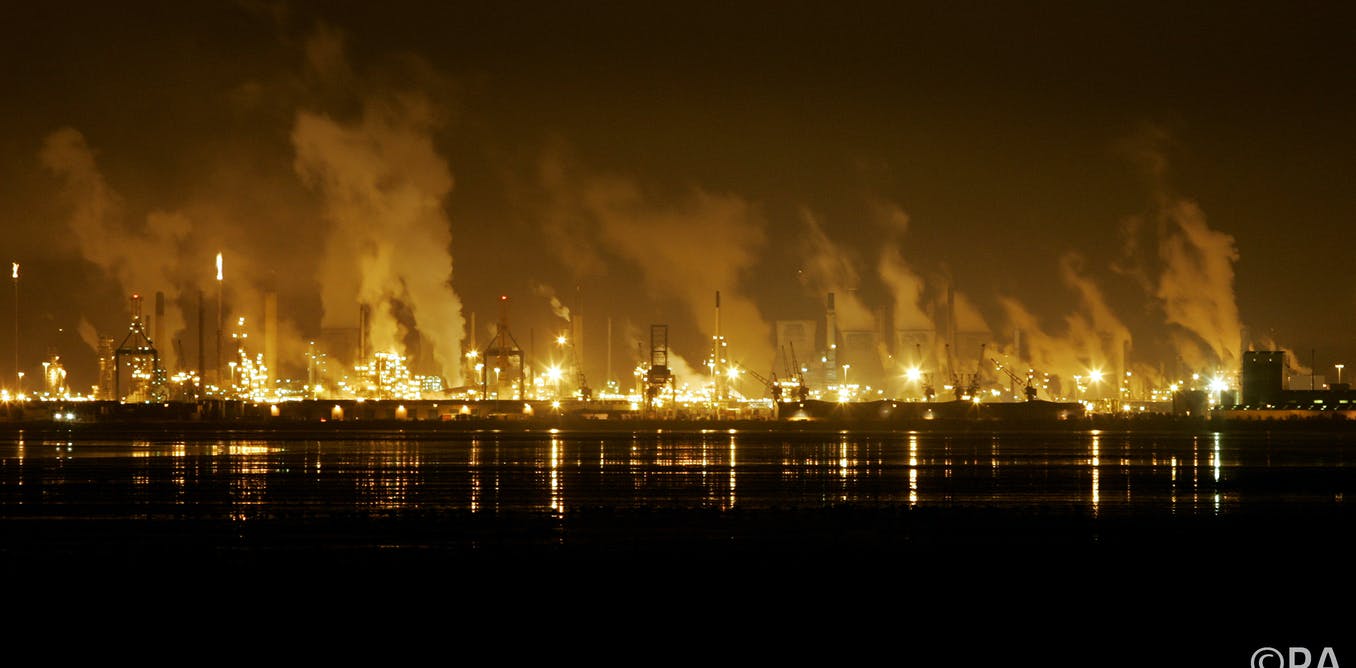After Quebec, what’s the future for Keystone XL?

Grangemouth refinery: keeping the home fire burning. Andrew MillJigan/PA
The runaway train of 73 oil tankers that derailed and exploded in the small town of Lac-Megantic in Quebec, Canada last week left 15 dead, around 50 missing, and shows how dangerous transporting oil can be.
An alternative to rail transport is the proposed, highly contested Keystone XL pipeline which would transport oil derived from Canadian tar sands in Alberta to refineries along the US Gulf Coast. The Obama administration has yet to decide whether to approve it.
That pipeline could reduce US dependence on foreign oil. But tar sands are a particularly carbon-intensive source of fuel, with the potential for leaks and spills from the pipeline along its proposed route through the heart of the US. Any decision will create winners and losers – either in the oil industry or environmental interests.
This whole debate would be unnecessary under a carbon tax or cap-and-trade policy that put a proper price on carbon and other greenhouse gas emissions. If oil companies had to pay the true social costs of producing gasoline, then they would have to charge a price high enough to cover not only production but also environmental costs. Then if consumers are willing to pay for that gasoline, they’re welcome to it. Each ton of carbon dioxide emissions is estimated to impose about $20 of costs on the rest of society, which would raise the cost of conventional gasoline by about twenty US cents per gallon.
The Keystone project to transport tar sands oil by pipeline means overcoming three problems. Because it is thick and viscous, the tar sand oil must first be diluted to a liquid before it can be transported. This requires additional energy and generates about 12% more CO2 emissions than conventional petrol. Second, this process generates huge amounts of semi-solid waste for which disposal is uncertain. Additionally, spills from the pipeline might damage ecosystems along its route – with particular concerns about pollution of Nebraska’s vast Ogallala Aquifer, an important water source.
Without paying these pollution costs, oil companies can make huge profits if the Keystone pipeline is built; environmentalists get a windfall if the Keystone is cancelled. It’s “winner take all”. But if oil companies did have to pay environmental costs, then Obama could just leave it up to oil companies: make them pay for all that pollution and then let them choose whether and how to use the tar sands. But without those payments to cover the environmental costs, we can’t really know if it’s a good idea or not.
Three recent events have raised the stakes. President Obama’s “Climate Action Plan” speech includes imposing emissions limits on power plants. Mentioning Keystone XL by name, Obama linked the pipeline not just to the environmental problems on its route but also to an increase in greenhouse gas emissions. But while he stated the project would not go ahead if it could be shown that greenhouse gas emissions would rise, he was vague about the “burden of proof” required.
Proponents say Obama’s requirement has already been met. Seeing, they argue, as tar sands will definitely be used one way or the other rather than left in the ground, pipeline transportation via Keystone will be the most carbon-effective method. Thus, according to them, the Keystone reduces emissions.
Just days after Obama’s speech came a decision in British Columbia on Canada’s west coast to reject the “Northern Gateway” pipeline, which would have provided an alternative to Keystone and brought tar sands oil from Alberta to the Pacific Ocean. That plan was scuttled by concerns about oil spills through the pristine British Columbian forests, the problems of building an oil tanker port on the beautiful Pacific coastline, and other subsequent problems.
The third event, of course, is the tragedy in Quebec. Railroad transport of oil hardly seems better than pipeline transport. Another alternative now drawing attention is to build a pipeline all the way from Alberta to the Atlantic. You have to give those Alberta oil interests some credit for persistence.
Ultimately, those tar sands can stay in the ground. After all, one policy to reduce global warming is to “sequester” atmospheric carbon by locking it into growing trees, reducing deforestation, or using carbon capture technology to store it deep underground. A shortcut route to sequestering carbon deep underground is to leave it there in the first place. Technology may advance fast enough to provide cleaner alternative fuels anyway, and the future introduction of a carbon tax or permit system might make tar sands too expensive to be viable.
Until we price the true cost of carbon and pollutants into our economy with a carbon price-per-ton, we prevent the market from doing what it does best. Without that, we allow gross profiteering in the oil and gas industry while leaving taxpayers to foot the bill.

Don Fullerton tidak bekerja, menjadi konsultan, memiliki saham, atau menerima dana dari perusahaan atau organisasi mana pun yang akan mengambil untung dari artikel ini, dan telah mengungkapkan bahwa ia tidak memiliki afiliasi selain yang telah disebut di atas.






